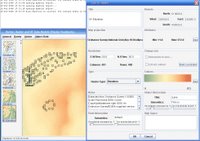
The Object-Field view of the world is considered to combine of both the discrete-object and continuous-field representations. The Object-Field model attempts to integrate the field and the object view in a single, combined and integrated data model. This is achieved by mapping locations in a field to objects. Aggregating field locations forms the objects. ). This model uses a single elementary spatial unit (hereafter object element) to exploit the benefits of continuous-field and discrete-object views. The object elements are associated with a field value and a variable number of object references. See an Object-Field example by Cova & Goodchild (checked 14 October 2006).
the discrete-object view of the world is considered as a series of entities located in space. An object is a digital representation of these entities. Objects are classified into different object types such as point objects (stores), line objects(retail network) and area objects (London Boroughs). These Objects are defined by their boundaries. In turn, we attach/associate one or more attributes with these objects to specify what is located at these places. These general classes are instantiated by specific objects and, we can attach behaviours to these objects
The continuous-field view of the world is made up of properties varying continuously across space. The key factors of the field view are spatial continuity and self-definition. As the key characteristics of the field view is spatial continuity and self-definition we are not forced to identify objects and their boundaries. In other words, the field is a collection of a certain kind of measurements (such as consumer’s spending behaviour) that are used to define a value everywhere in the field and it is the values themselves that define that field.



No comments:
Post a Comment